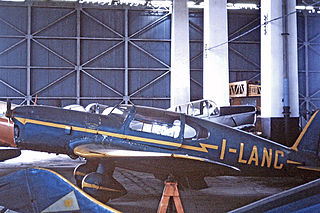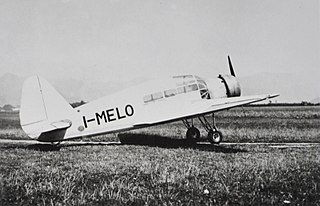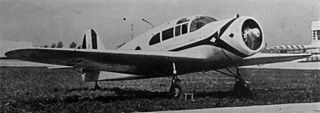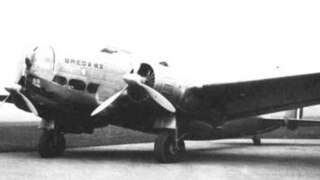
The Savoia-Marchetti S.74 was a four-engine airliner developed by Savoia-Marchetti for Ala Littoria.
The Ambrosini SAI 1 was a two-seat biplane aircraft built in Italy to compete in the 1935 Avioraduno del Littorio rally. It was of conventional configuration, and featured a neatly cowled radial engine and a long canopy fairing for added streamlining.
The Ambrosini SAI.2 was a light monoplane built in Italy in 1934. Like the SAI.1, it was designed to participate in the Avioraduno del Littorio rally of 1935. Compared with that aircraft, the SAI.2's wing area was only 1.4 m2 (15 ft²) less, but the reduction in drag as a result of the monoplane configuration versus that of a biplane resulted in a top speed 20 km/h (12 mph) higher. Both aircraft used the same engine type.

The Ambrosini SAI.2S was a four-seat light aircraft produced in Italy shortly before World War II.

The Ambrosini SAI.10 Grifone ("Griffon") was a military trainer aircraft produced in small numbers for the Italian Regia Aeronautica early in World War II. With the approach of war, the Ministero dell' Aeronautica began a programme to increase the number of pilots available, and ordered a prototype primary trainer from Ambrosini. This aircraft, a parasol monoplane of mixed construction, first flew on July 8 1939 with Guiliano Ferrari at the controls. A production batch of 50 was ordered, but this was quickly reduced to just 10 machines, all of which were delivered in 1940.

The Caproni PS.1, also known as the Pallavicino PS-1 and Caproni Ca.303, was an Italian four-seater sportsplane, designed and built specifically to compete in Challenge 1934, the European touring plane championships.

The Caproni Ca.165 was an Italian biplane fighter developed just before World War II, but produced only as a prototype, as the competing Fiat CR.42 Falco was selected for series production.
The Piaggio P.32 was an Italian medium bomber of the late 1930s, produced by Piaggio, and designed by Giovanni Pegna. It was a modern design for its time, but was a failure due to lack of powerplants commensurate with its high wing loading.

The IMAM Ro.51 was an Italian fighter aircraft that first flew in 1937. It was designed for the 1936 new fighter contest for the Regia Aeronautica, with practically all the Italian aircraft builders involved.

The IMAM Ro.57 was an Italian twin-engined, single-seat monoplane fighter of the Regia Aeronautica. Based on a 1939 design by Giovanni Galasso the aircraft did not enter production until 1943.

The CANT Z.509 was a three-engine Italian floatplane developed from the Z.506A for use as a mailplane.

The Fiat AS.1 was a light touring aircraft developed in Italy in the late 1920s. It was a basic and conventional design: a parasol wing monoplane with tailskid undercarriage and seating for two in tandem open cockpits. The type proved extremely popular, and the production run would eventually extend to over 500 machines, with roughly half of these purchased by the Regia Aeronautica as trainers and liaison aircraft. Construction was of wood throughout, covered by plywood, fabric, and metal. A later development, designated TR.1 featured a metal structure and a shorter span wing.

The Nardi FN.310 was an Italian four-seat touring monoplane similar but larger than the earlier Nardi FN.305 and produced by the Fratelli Nardi company.

The Macchi MB.323 was an Italian single-engine basic training monoplane designed and built by Macchi. No orders were placed and only a prototype was built.

The Breda Ba.32 was an Italian airliner prototype designed and built by the Breda company.

The Breda Ba.82 was an Italian medium bomber prototype of the late 1930s; it was designed and built by the Breda company.

The Magni Vale PM-3-4 was an Italian civil monoplane for use as a tourer or aerobatic trainer designed and built by Piero Magni-Aviazione in Milan.

The CANSA FC.20 was a twin engine reconnaissance bomber/ground attack monoplane designed and built in Italy in 1941. Several versions with different armament and engines were flown but only the FC.20bis ground attack variant reached squadron service, in very small numbers, before the 1943 armistice.
The CNA Eta was a single engine Italian light aircraft, flown in the mid-1930s, that set one and two seat world records as both a landplane and a seaplane. Only one or two were built.

The Savoia-Marchetti SM.80 was a two-seat monoplane amphibian tourer, with a single, tractor engine mounted above the wing, designed in Italy in the early 1930s. The SM.80bis was a four-seat variant, powered by two pusher engines.
















